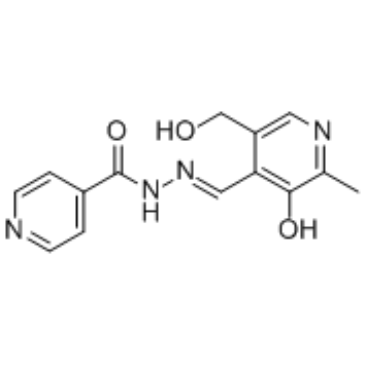CHEMICAL IDENTIFICATION
-
RTECS NUMBER :
-
US5760000
-
CHEMICAL NAME :
-
4-Pyridinecarboxylic acid, ((3-hydroxy-5-(hydroxymethyl)-2-methyl-4-pyridinyl)me thylene) hydrazide
-
CAS REGISTRY NUMBER :
-
737-86-0
-
LAST UPDATED :
-
199612
-
DATA ITEMS CITED :
-
5
-
MOLECULAR FORMULA :
-
C14-H14-N4-O3
HEALTH HAZARD DATA
ACUTE TOXICITY DATA
-
TYPE OF TEST :
-
LD50 - Lethal dose, 50 percent kill
-
ROUTE OF EXPOSURE :
-
Oral
-
SPECIES OBSERVED :
-
Rodent - rat
-
DOSE/DURATION :
-
5 gm/kg
-
TOXIC EFFECTS :
-
Behavioral - somnolence (general depressed activity) Behavioral - food intake (animal) Kidney, Ureter, Bladder - other changes in urine composition
-
REFERENCE :
-
DCTODJ Drug and Chemical Toxicology. (Marcel Dekker, 270 Madison Ave., New York, NY 10016) V.1- 1977/78- Volume(issue)/page/year: 14,395,1991
-
TYPE OF TEST :
-
LD50 - Lethal dose, 50 percent kill
-
ROUTE OF EXPOSURE :
-
Intraperitoneal
-
SPECIES OBSERVED :
-
Rodent - rat
-
DOSE/DURATION :
-
1100 mg/kg
-
TOXIC EFFECTS :
-
Behavioral - somnolence (general depressed activity) Behavioral - food intake (animal) Liver - fatty liver degeneration
-
REFERENCE :
-
DCTODJ Drug and Chemical Toxicology. (Marcel Dekker, 270 Madison Ave., New York, NY 10016) V.1- 1977/78- Volume(issue)/page/year: 14,395,1991
-
TYPE OF TEST :
-
LD50 - Lethal dose, 50 percent kill
-
ROUTE OF EXPOSURE :
-
Oral
-
SPECIES OBSERVED :
-
Rodent - mouse
-
DOSE/DURATION :
-
4500 mg/kg
-
TOXIC EFFECTS :
-
Behavioral - somnolence (general depressed activity) Behavioral - food intake (animal) Kidney, Ureter, Bladder - other changes in urine composition
-
REFERENCE :
-
DCTODJ Drug and Chemical Toxicology. (Marcel Dekker, 270 Madison Ave., New York, NY 10016) V.1- 1977/78- Volume(issue)/page/year: 14,395,1991
-
TYPE OF TEST :
-
LD50 - Lethal dose, 50 percent kill
-
ROUTE OF EXPOSURE :
-
Intraperitoneal
-
SPECIES OBSERVED :
-
Rodent - mouse
-
DOSE/DURATION :
-
1 gm/kg
-
TOXIC EFFECTS :
-
Behavioral - somnolence (general depressed activity) Behavioral - food intake (animal) Liver - fatty liver degeneration
-
REFERENCE :
-
DCTODJ Drug and Chemical Toxicology. (Marcel Dekker, 270 Madison Ave., New York, NY 10016) V.1- 1977/78- Volume(issue)/page/year: 14,395,1991 ** OTHER MULTIPLE DOSE TOXICITY DATA **
-
TYPE OF TEST :
-
TDLo - Lowest published toxic dose
-
ROUTE OF EXPOSURE :
-
Oral
-
SPECIES OBSERVED :
-
Rodent - rat
-
DOSE/DURATION :
-
72 gm/kg/90D-C
-
TOXIC EFFECTS :
-
Nutritional and Gross Metabolic - other changes Biochemical - Enzyme inhibition, induction, or change in blood or tissue levels - phosphatases Related to Chronic Data - death
-
REFERENCE :
-
DCTODJ Drug and Chemical Toxicology. (Marcel Dekker, 270 Madison Ave., New York, NY 10016) V.1- 1977/78- Volume(issue)/page/year: 14,395,1991
|
